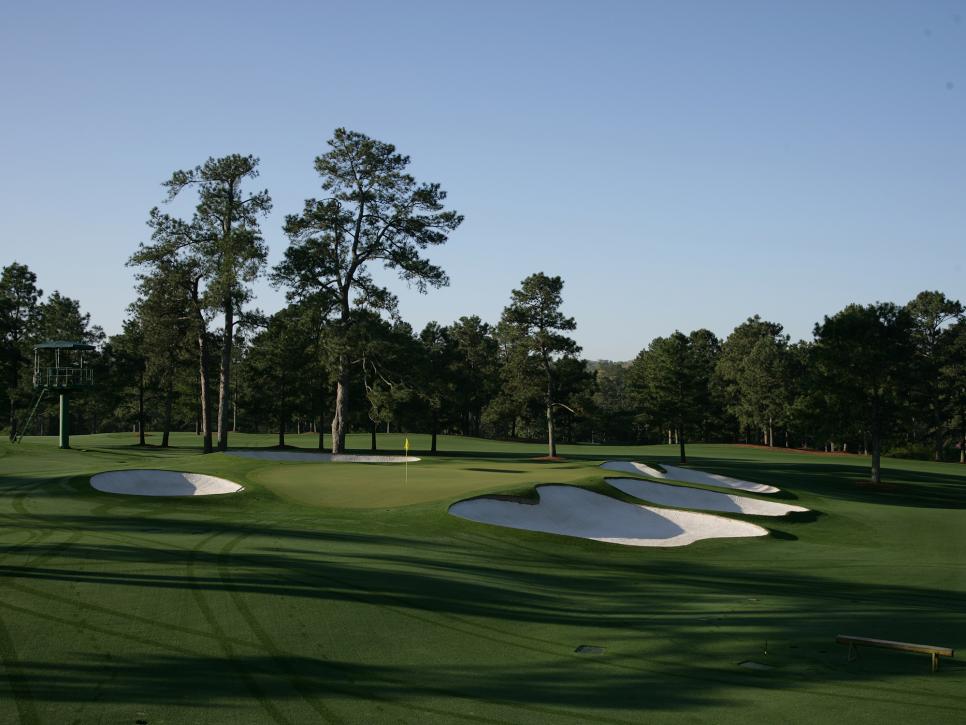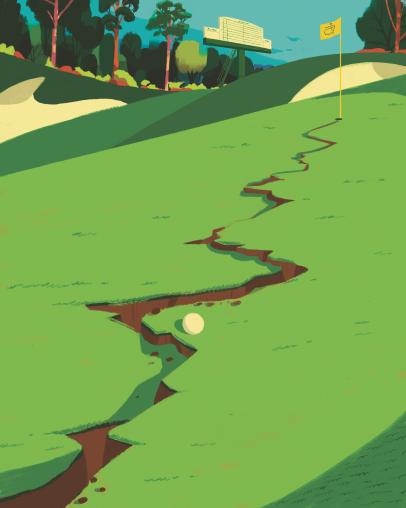Eye on Design
The strange journey of the seventh hole at Augusta National shows how the course is always changing

Stephen Szurlej
One of the tricks Augusta National manages to pull off is to make the course appear the same each spring. We know it never is. Nearly every year the club modifies holes in reaction to changes in the professional game, unwanted Masters scoring trends or for infrastructure purposes.
Yet, from a distance, Augusta National is still Augusta National, as instantly recognizable as any course in the world. Though change is constant, the modifications happen gradually, often subtly, a hole or two at a time, so the impacts are nearly imperceptible. The architectural premise was always to provide space off the tee but entice players to hit to specific fairway positions—positions that varied round to round—to play the most advantageous shots to changing hole locations. The strength and power of the modern professional game, however, has motivated the club to fortify its design by adding yardage and tightening fairways with trees and rough.
No hole illustrates how Augusta National has deviated both stylistically and structurally better than the par-4 seventh. Alister MacKenzie and Bob Jones conceived of it in the early 1930s as a short par 4 modeled after the 18th at St. Andrews with a wide fairway giving players the opportunity to work angles into a wide green with a Valley of Sin depression in the front.

Image courtesy of Josh Pettit
Earliest tweaks
Early Masters competitors thought the hole was too short and too tricked up, so after several tournaments the club hired Perry Maxwell, who worked with MacKenzie before his passing in 1934, to make modifications. Maxwell moved the green back toward a small hill and “modernized” it by fronting it with three bunkers.

1948 (Getty)

The seventh hole in 1949 (Getty)
From that point on, the seventh was a drive-and-pitch hole demanding an aerial approach to a tiny putting surface, unique among the other par-4 holes that had larger greens receptive to running approaches. Through the 1960s, a drive of just 230 yards would reach a wide clearing past most of the pines, allowing players to aim right or left and hit into the length of the shallow, elevated green from the sides.
By the 1970s, trees planted down the left side of the fairway were maturing, lessening the ability to play angles, though at just 365 yards and with no rough there was still room to consider a variety of shots off the tee.

In 1964 players could still drive past the pines for a wide approach. (Getty)
Bunkers added behind

Notice how shallow and far removed from the green the bunkers are in 1950 (Getty)
Two more bunkers were built behind the green in the 1950s, but their shapes were far less formal with patchy grass edges. They were also much shallower and simpler to play from than they are now, though their bottoms started to be carved out beginning in the 1960s.
The structure of the seventh hole remained fairly constant through the 1980s and 90s, but its appearance—and the appearance of the entire course—gradually became more polished and pristine. The bunkers continued to deepen, and their faces made steeper with the sand flashed up toward exposed edges that increasingly looked like they were cut with scalpels. They also migrated closer to the putting surface with their top lines rising above the level of the green.

A look at the seventh in the early 1980s. (Getty)
New tees were built in 2002 and again in 2011, lengthening the seventh to 450 yards. The club also added more pines to tighten the drive, pinching the fairway to U.S. Open dimensions of just 27 yards.
With five greenside bunkers and uniform emerald turf, the seventh is one of Augusta National’s most artistic holes. The alterations have made it play marginally more difficult in relation to par, but also more one-dimensional.

By the late 80s the bunkering had become more formalized and deep. (Getty)
Decades ago, as a tantalizing drive-and-pitch hole, the real defense was the putting surface that Maxwell designed with wave-like movement and high and low cupping areas. Placing the ball off the tee to access the best angle and distance into different pins was the key to attacking the hole. For instance, players might want to set up a shot to flags on the elevated rear-left plateau of the green with a drive down the right, and perhaps lay back a little in order to hit in with a club with less spin. It was up to each player to determine the strategy and level of aggression.
The tactics are now defensive, and players are just trying to find the fairway. When drives do end up in the trees, with little opportunity to manufacture a creative or curving shot, they often just hit to the front bunkers and try to get up and down. Those Maxwell green contours still exist, but with no options off the tee and slightly longer clubs played on the approach, most are content if they hit the green and two-putt.

Getty
The hole is most interesting when the pin is placed in the front-right bowl—players expect to make birdie when it’s there and feel like they’ve lost a stroke to the field if they don’t. Otherwise, they simply want to make 4 here and move on.
Not every hole at Augusta National has undergone such fundamental change. But it’s been a long, strange journey for the seventh, and it’s the best example of how style and identity can change through time, and an indication of the lengths even the best tournament courses will go to address questions posed by the modern professional game. The answer in this case has been to take away the hole’s dynamic quality.





